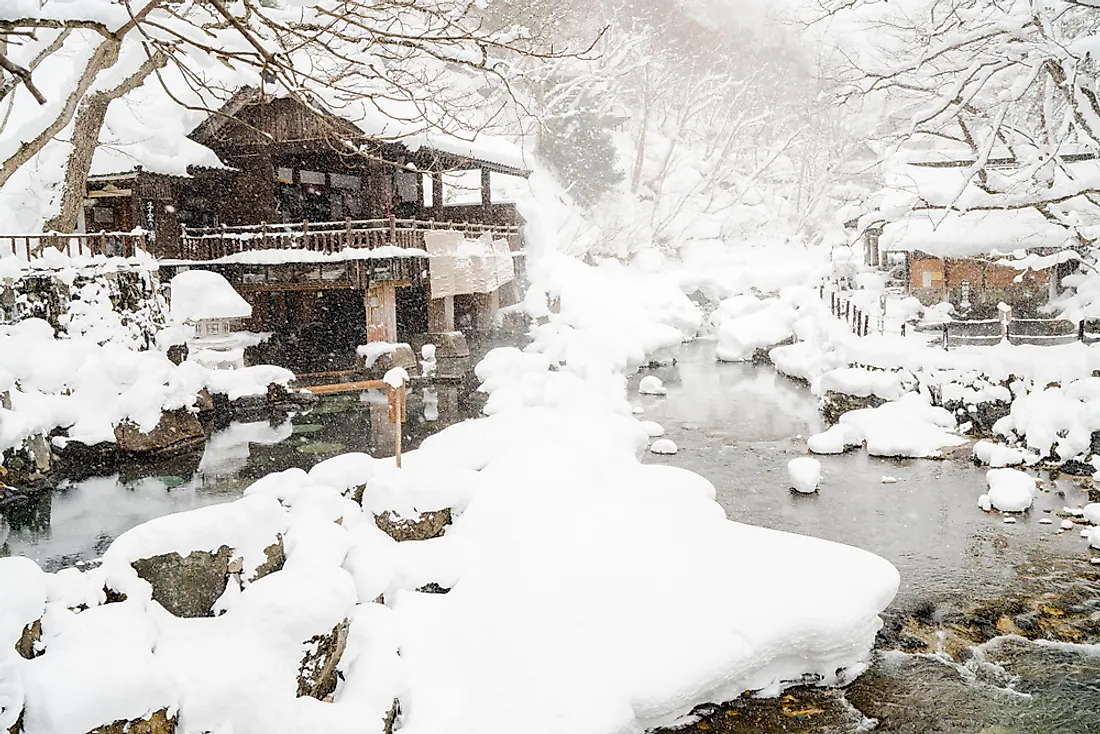Where is Japan's Snow Country?

Japan's Snow Country is located on the western coast of Japan, particularly the islands of Honshu and Hokkaido. In the Japanese language, this area is known as "yukiguni". It is also known as "gosetsu chitai", which means "heavy snow area". That is exactly what Japan's snow country is. This is a geographic area within Japan known for heavy snowfall. Not only does it get the most snowfall in Japan, it is among the snowiest places on the planet. Snow country is to Japan what the Snow Belt is to the Great Lakes region of North America.
Geography of Japan's Snow Country
Understanding Japan's Snow Country must first begin by understanding the geography of this region. The reach of Japan's Snow Country extends from Shimane and Yamaguchi Prefectures in southern Honshu to Hokkaido's western coast. Japan is an island nation bordered by the Pacific Ocean on its eastern coast, and the Sea of Japan on its western coast. The location of Japan's western coast plays a crucial role in why this region is Japan's Snow Country.
How the Region's Heavy Snowfall Occurs
Japan's western coast gets a snow-related phenomenon similar to lake-effect snow. This is known as sea-effect snow. Japan is the easternmost country in the East Asia region and it is located outside of the continental mainland, separated from the mainland by the Sea of Japan. This sets up the perfect factors for sea effect snow. During the winter, the Siberian High Pressure system dominates over Asia. This brings cold winds from Siberia. These cold winds blow from west to east. These winds over the relatively warmer Sea of Japan. As they make their way over the Sea of Japan, moisture will rise in the form of water vapor, to the point where condensation takes place. With the air below freezing, precipitation falls on Japan's western coast in the form of snow. Large amounts of snow are produced in the same way that lake effect snow occurs.
Comparing the Sea of Japan to the Great Lakes
What sets the deep snows of Japan's snow country from the lake effect snow of the Great Lakes in North America is the body of water. The North American Great Lakes are bodies of freshwater. Fresh water freezes at 32 degrees Fahrenheit (0 degrees Celcius). The Sea of Japan, however, is a body of saltwater. It is a smaller part of the much larger Pacific Ocean. The Sea of Japan can generate more snow because the water will stay at a liquid state in much colder temperatures than freshwater lakes would. Because the Sea of Japan is far less likely to freeze over, there is a constant supply of water vapor that rises and is picked up by cold winds. This not only generates large amounts of snow, it generates large amounts of snow for long periods of time. It is common to receive as much as 5 metres (16.4 feet) of snow. The city of Niigata, located in this region, averages 85 inches (217 cm) of snow annually. Even more interesting, Niigata has somewhat mild winters for a location that gets large amounts of snow. The effect of the sea can be credited for this. Niigata has an average January temperature of 37 degrees Fahrenheit (2.8 degrees Celcius). However, the moisture from the Sea of Japan and cold winds from Siberia play a strong role.
Human Impact of Snow Country's Heavy Snows
The deep snows of western Japan give it the fitting name "Snow Country". These snows can have an immense impact for people. These deep snows reach the nearby Japan Alps. The Japan Alps receiving so much snow plays a major role for skiing. Japan has the highest number of ski resorts in Asia. Japan is second to the US when it comes to the number of ski resorts in the country. There are at least 300 ski resorts in Japan. The deep snows are a major reason for this, providing ample snow for skiing. The deep snows can also be a liability. Heavy snowfall can cause problems with transportation. Snow removal equipment is often a necessity to keep things in an orderly way and to prevent problems with transportation. Many buildings in Japan's Snow Country come with an entrance higher up in the building in the case of the main entrance being blocked by snow. Japan's Snow Country is well known within the country. It has a novel named for it, written by Yasunari Kawabata.











